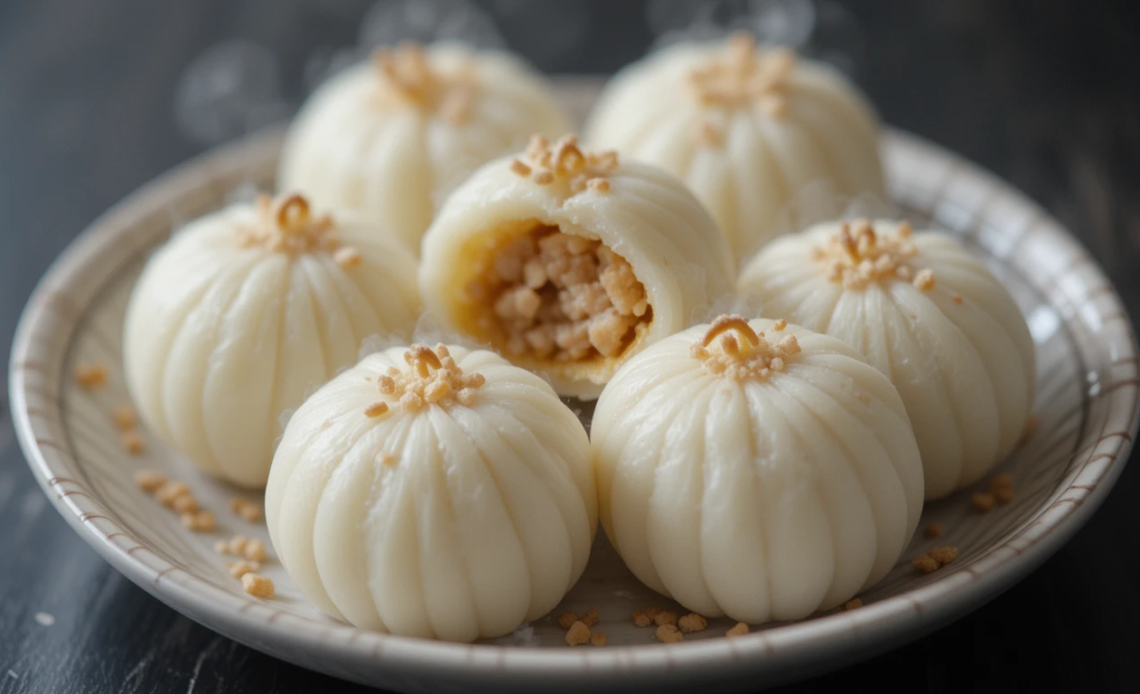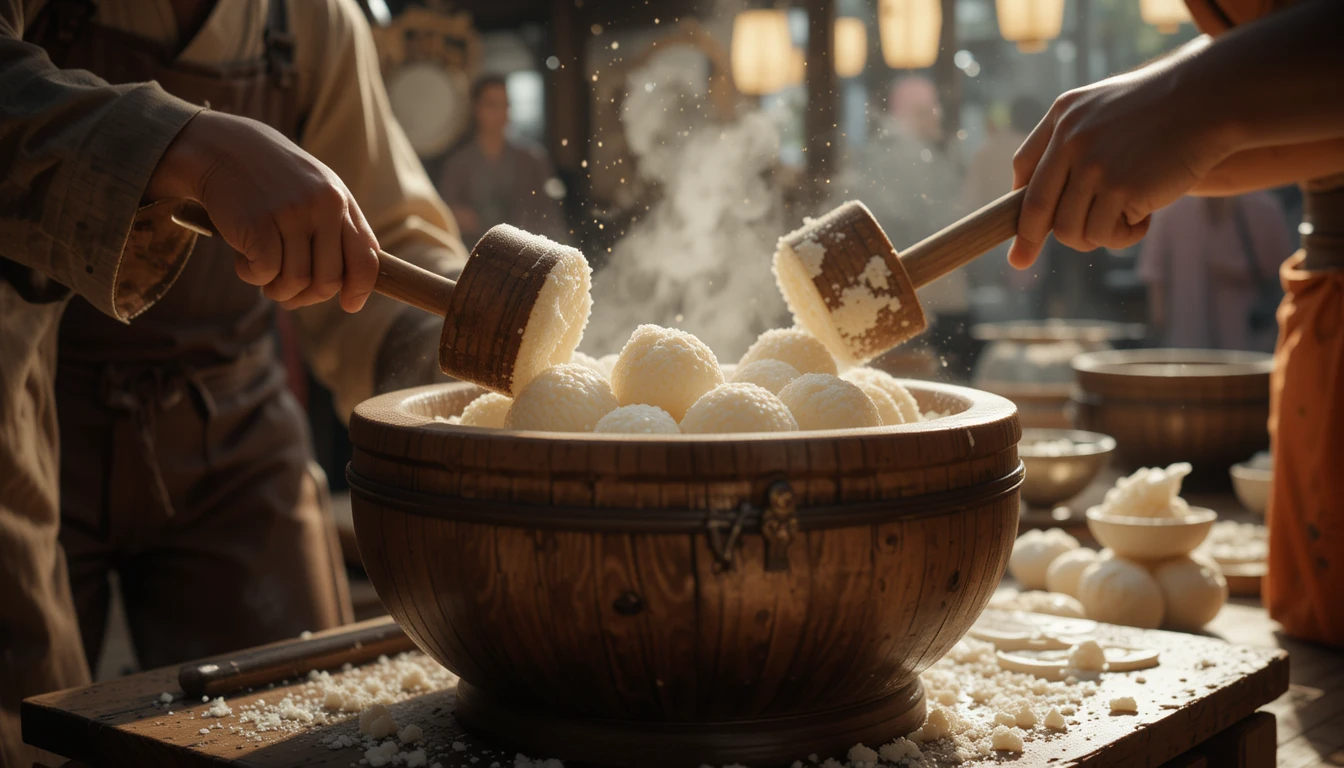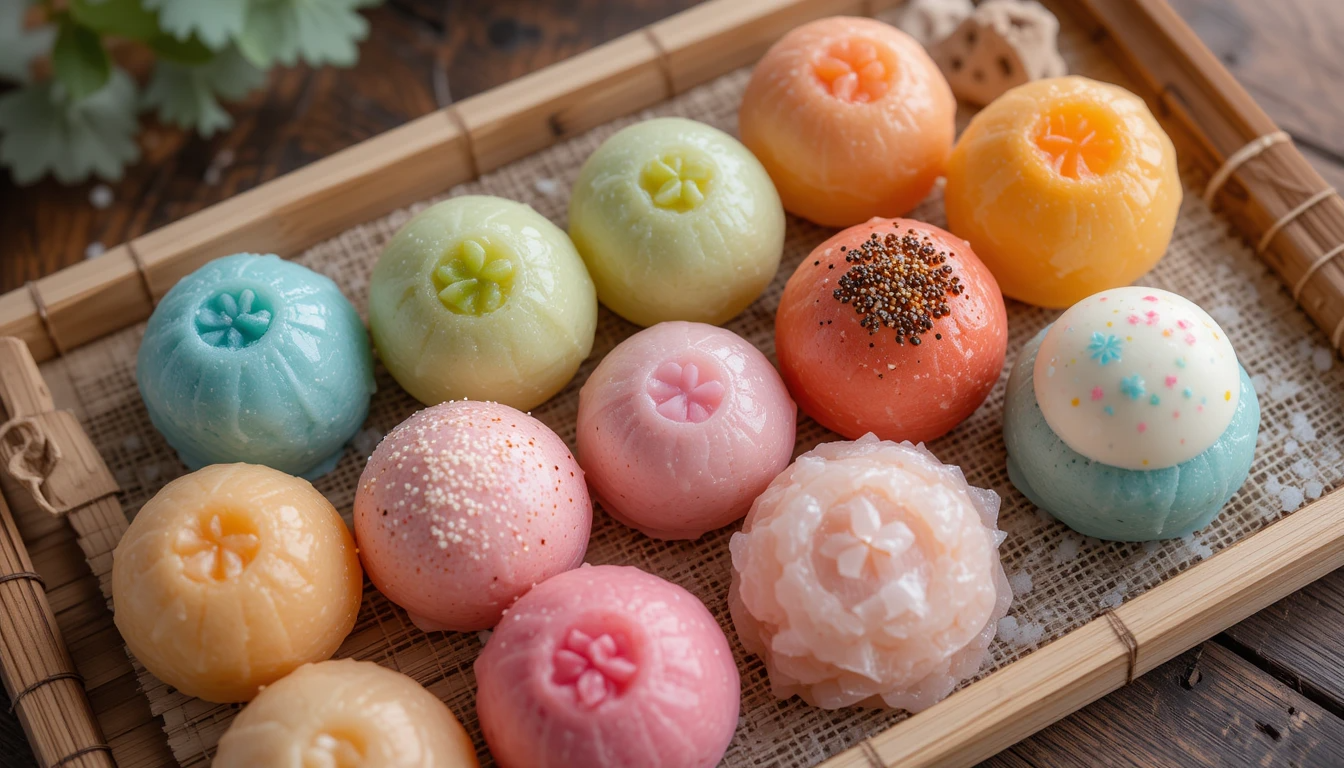
Mochi is a beloved Japanese rice cake made by pounding glutinous rice into a delightfully chewy treat.
It symbolizes celebration in many Japanese festivals and has garnered global attention for its unique texture.
From sweet fillings to savory variations, Mochi offers you an irresistible fusion of fun and flavor.
Table of Contents
Introduction
You walk into a bustling street fair and spot a crowd gathered around an old-fashioned wooden mortar. The rhythmic thud of wooden mallets against steamed glutinous rice piques your curiosity. You inch closer, discovering a mesmerizing tradition called mochitsuki, where teams of people pound and turn steamed rice until it transforms into a sticky, dough-like mass. Suddenly, the excitement around this ancient practice makes perfect sense: *freshly made Mochi * is more than a snack—it’s an experience. Whether you’re new to this chewy delight or a longtime fan, Mochi exudes a playful sense of discovery in every bite.
Yet beyond its chewy exterior lies a tapestry of culture, history, and even a few surprising bits of nutritional information. No wonder countless foodies have fallen in love with Mochi . This article takes you on a deep dive into its origins, its modern adaptations, and essential tips on enjoying it safely. By the end, you’ll know how to pick the best type for your tastes, how to appreciate its cultural significance, and even how to store it properly. So get comfy—you’re in for a truly delightful journey through the world of Mochi .
(Disclaimer: This article is for informational purposes only and does not replace professional veterinary advice, medical advice, or any specialized consultations. Always exercise caution when trying new foods or sharing them with pets, as individual allergies or sensitivities can vary.)
The Origins of Mochi

Mochi traces back centuries in Japan, where it evolved from a sacred food into an everyday treat. Historical records suggest that during the Heian period (794–1185), Mochi was prized among the nobility and often reserved for religious offerings. These early forms of Mochi , known in various dialects, symbolized good fortune, longevity, and community bonding. Even today, the tradition of pounding rice to make Mochi—called mochitsuki—is woven into significant Japanese festivals, notably around the New Year.
Cultural Significance
- New Year’s Ritual: In Japan, it’s customary to make or buy Kagami Mochi , a decorative set of layered rice cakes. Placed inside homes, this tower of chewy goodness represents prosperity and good health for the upcoming year.
- Community Bonding: Groups gather to participate in mochitsuki, sharing the labor-intensive pounding process. This communal activity fosters connection and signals the coming of a fresh season.
- Ritual Offerings: Historically, Mochi was offered to Shinto gods as a token of gratitude and reverence. Even modern households sometimes maintain these offerings, acknowledging tradition in a contemporary setting.
Beyond these ceremonial roles, Mochi has become a widely available street food and supermarket staple, sometimes paired with sweet red bean paste or stuffed with ice cream for a modern twist. Thanks to globalization, Mochi now appears in various fusion dishes—from Mochi pizza crust to Mochi donuts—demonstrating its chameleon-like adaptability in cuisines worldwide.
How Mochi Is Made: The Art of Mochitsuki

Mochi starts with a simple ingredient: glutinous rice (often called mochigome in Japanese). The process, however, transforms plain rice into a magical, chewy texture that people can’t seem to resist. Traditional mochitsuki involves soaking the glutinous rice overnight, steaming it to perfection, and then pounding it with wooden mallets in a mortar. Two or more people alternate strikes, turning the dough between mallet drops to ensure even consistency.
Here’s a simplified step-by-step outline of how Mochi is traditionally crafted:
- Soaking the Rice: Glutinous rice is soaked for several hours or overnight to achieve the right moisture level.
- Steaming: Once soaked, the rice is steamed in a large steamer basket until it’s fully cooked, soft, and sticky.
- Pounding: The steamed rice is transferred into a sturdy mortar. One person pounds it with a mallet, while another wets and flips the dough, ensuring a smooth consistency.
- Shaping: After sufficient pounding, the resulting dough is portioned out, often rolled into small round cakes or filled with sweet pastes.
- Storage: Fresh Mochi is incredibly soft and tends to harden over time. It’s often eaten immediately or sealed in packaging if store-bought, to maintain freshness.
Modern methods, especially in home kitchens, might replace the labor of wooden mallets and mortar with Mochi -making machines. These devices automate the process, making fresh Mochi more accessible to anyone who craves that signature chew. Still, many enthusiasts argue that the traditional pounding method imbues the dough with a special depth of flavor and a certain intangible soul.
Health and Nutritional Profile
Mochi might be synonymous with celebration, but it also has some interesting nutritional characteristics. Though it’s primarily composed of carbohydrates, it can provide a small amount of protein. Keep in mind, however, that portion control is crucial, as some modern adaptations—like Mochi ice cream—come packed with added sugar.
Below is a sample nutritional breakdown for a plain, unsweetened 100-gram serving of Mochi . This data is approximate and can vary depending on the brand or how it’s prepared.
| Nutrient | Approximate Amount per 100g of Plain Mochi |
|---|---|
| Calories | 210 kcal |
| Carbohydrates | 46 g |
| Protein | 4 g |
| Fat | 0.5 g |
| Sodium | < 5 mg |
| Fiber | 1 g |
While Mochi provides a quick energy boost from its high-carb content, it’s also quite sticky and dense. Enjoying it in moderation is especially important if you’re watching your sugar intake or overall caloric balance. Always check labels for sweetened versions that can elevate the carbohydrate and calorie count significantly.
For individuals with certain dietary restrictions—like gluten intolerance—plain Mochi often serves as a welcome alternative because it’s naturally gluten-free (glutinous rice does not contain gluten). However, if fillings or flavorings are added, that might change, so reading ingredient lists is key.
(Note: If you have concerns about food sensitivities, it’s best to consult a healthcare professional. Also, practice caution when sharing Mochi with pets, as many human foods aren’t safe for animals. Consult a veterinary professional if you’re unsure.)
Varieties of Mochi
Mochi appears in countless shapes, colors, and flavor profiles. Here are just a few of the most popular:
- **Daifuku Mochi **: Typically filled with sweet red bean paste. Some variations add fresh fruit like strawberries.
- **Sakura Mochi **: Pink-hued Mochi flavored with cherry blossoms and wrapped in a pickled sakura leaf. It’s a springtime favorite, especially during hanami (cherry blossom viewing).
- **Kusa Mochi **: Green-colored Mochi that gets its hue from yomogi (Japanese mugwort). Has a slightly herbal taste.
- Mochi Ice Cream: A modern treat featuring a thin layer of Mochi wrapped around ice cream. Common flavors include matcha, vanilla, and chocolate.
- Isobeyaki: Grilled Mochi that’s often basted with soy sauce and wrapped in seaweed. A savory variant that appeals to fans of salty-sweet combinations.
These variations highlight the versatility of Mochi . It can go from sweet to savory in seconds, making it a great canvas for creative chefs around the world. Want a dessert twist? Stuff it with ice cream or fruit. Craving something savory? Grill it and dip it in soy sauce for a smoky, umami-rich snack.
Potential Concerns: Choking Hazards and Safe Consumption
While Mochi is celebrated for its chewiness, that very texture can pose a serious choking risk, particularly for children, the elderly, and even healthy adults if not eaten carefully. Data from Japanese news outlets, occasionally citing local health authorities, indicate that every year, a number of choking incidents are reported, especially around the New Year when Mochi consumption spikes.
How to Eat Mochi Safely
- Chew Thoroughly: Due to its stickiness, take small bites and chew well before swallowing.
- Stay Hydrated: Have water or tea on hand to help wash it down.
- Supervise Vulnerable Individuals: If you’re serving Mochi to children or elderly relatives, ensure they eat slowly and have assistance if needed.
- Consider Softened Forms: For those who are at higher risk, opt for thinner or mashed versions of Mochi to reduce the choking hazard.
(Disclaimer: If you suspect someone is choking, follow emergency protocols or the Heimlich maneuver guidelines. Always prioritize safety when handling sticky foods.)
Modern Twists: Beyond the Traditional

Mochi has long broken free from the confines of purely traditional Japanese cuisine. Today, you can find:
- Mochi Waffles: Batter enriched with Mochi flour for a crisp-yet-chewy breakfast treat.
- Mochi Donuts: Popularized by specialty shops, these donuts have a characteristically bouncy feel.
- Mochi Pizza Crust: Achieves a unique texture that’s crispy on the outside and chewy on the inside.
- Fusion Desserts: Chefs add Mochi elements to pastries and sweets worldwide, bridging Eastern and Western dessert cultures.
This innovative spirit demonstrates that Mochi remains relevant in a rapidly evolving food scene. Chefs and home cooks alike experiment with everything from vibrant rainbow colors to quirky shapes, ensuring that Mochi consistently captures the culinary spotlight. If you’re feeling adventurous, you can even try making a Mochi -inspired dish at home using glutinous rice flour (sometimes labeled as Mochiko) to yield that signature chew.
Storing and Handling Mochi
Mochi tends to harden relatively fast, especially when exposed to air. If you’ve made a fresh batch at home, a common technique is to wrap individual pieces in plastic wrap and keep them in the freezer. This prevents them from drying out and lets you thaw or microwave small portions whenever a craving strikes. For store-bought versions, always check the packaging for handling instructions and expiration dates.
Tips for Longer Freshness
- Room Temperature: If storing plain Mochi for a short while, keep it sealed and out of direct sunlight or heat sources.
- Refrigeration: This can cause Mochi to harden more quickly. Reheating or microwaving briefly can restore some softness.
- Freezing: Wrap in airtight packaging to maintain texture and flavor for a few weeks. Thaw gently before serving.
Keep in mind that filled Mochi (like Mochi ice cream) typically requires freezer storage to maintain quality. In these cases, always follow the brand’s recommended instructions. Improperly stored Mochi can grow mold or degrade in flavor faster.
Mochi and Cultural Festivals
During special events such as Hinamatsuri (Doll’s Festival) or Kodomo no Hi (Children’s Day), Mochi often appears in colorful arrays, each symbolizing different wishes like health, happiness, or success. At New Year’s, families prepare Ozoni, a savory soup featuring Mochi at its core. Different regions in Japan put their own twist on this soup—some using miso-based broths, others using clear dashi—proving that Mochi is truly a national treasure in terms of culinary diversity.
A Personal Touch
Many families pass down their own Mochi traditions, such as specific recipes or shapes that have been in their lineage for generations. In some households, Mochi is the centerpiece of important milestones, from birthdays to weddings, further underlining the chewy treat’s deep cultural roots. By sharing these family recipes, each generation keeps the Mochi tradition alive, bridging past and present.
Mochi for Pets? A Word of Caution
Given Mochi ’s growing international fame, pet owners might wonder if a small nibble is safe for their furry companions. While plain Mochi made from pure glutinous rice is technically not toxic to dogs or cats, its dense, sticky consistency can be hazardous. Pets might swallow it without adequate chewing, risking choking or digestion issues. Furthermore, many Mochi variations contain sugar, artificial flavors, or other ingredients (like chocolate) that are unsafe for animals.
Veterinary Disclaimer: Always consult a professional veterinarian before offering human foods to your pet. Since Mochi is a high-carbohydrate snack, it could disrupt an animal’s dietary balance. Additionally, certain flavorings or fillings can be harmful or even fatal to pets.
Notable Mochi -Related Events and Tourism
If you love the spectacle of food traditions, heading to Japan to witness real mochitsuki events is a bucket-list experience. In rural villages, you might find entire communities gathering for the pounding ritual. Large cities often host festivals where you can enjoy diverse Mochi flavors, from matcha-infused confections to seasonal specialties. Tourist-friendly areas may even allow you to participate, letting you swing the mallet and feel the sticky dough transform in your hands.
For those who can’t travel all the way to Japan, many cultural festivals in the United States and beyond feature Mochi demonstrations, especially in communities with significant Japanese heritage. Keep an eye out for these gatherings—no matter where you are, you might discover an opportunity to join in the Mochi -making fun.
Mochi : A Global Perspective
Mochi has traveled far beyond Japan, evolving into a global phenomenon. Whether it’s consumed as a sweet snack in Hawaii (where Mochi butter cake is a local favorite) or as an upscale dessert in high-end fusion restaurants across Europe, this traditional rice cake continues to reshape international dessert menus. Chefs laud Mochi for its versatility, using it as a canvas for everything from bright fruit fillings to savory dips.
In regions like Southeast Asia, you’ll find local twists—think pandan-flavored Mochi or durian fillings. Each culture adapts the sticky rice concept to fit its own flavor palette, showing that Mochi is not just a Japanese treat but a global staple in the making. Its unique mouthfeel and culturally rich story remain a magnet, drawing food enthusiasts from every corner of the globe.
Culinary Experiments You Can Try at Home
Ready to integrate Mochi into your home cooking repertoire? Here are some beginner-friendly ideas:
- Homemade Daifuku: Purchase glutinous rice flour (Mochiko), sugar, and your preferred filling (e.g., sweet red bean paste). Steam or microwave the dough mixture, then wrap it around the filling.
- Mochi Pancakes: Replace part of your flour with Mochiko for fluffier, chewier pancakes. Add fresh fruit or chocolate chips for a playful twist.
- Mochi Waffles: Use a waffle iron with a mixture of regular flour and glutinous rice flour. The resulting waffles come out with crisp edges and a chewy center.
- Mochi Dumplings: Roll small Mochi balls and drop them into soups or stews for added texture.
- Creative Toppings: Drizzle sweetened condensed milk, sprinkle kinako (roasted soybean powder), or dust your Mochi with powdered sugar for extra flair.
(Tip: Always handle hot Mochi dough with caution. It can stick to your hands or utensils, so dust everything with cornstarch or potato starch to reduce the mess.)
Table of Sweet vs. Savory Mochi Uses
If you’re overwhelmed by the sheer variety, here’s a quick rundown of sweet vs. savory uses of Mochi :
| Category | Sweet Uses | Savory Uses |
|---|---|---|
| Classic | Daifuku (red bean filling), Kusa Mochi | Isobeyaki (soy sauce, seaweed) |
| Modern | Mochi ice cream, Mochi donuts | Mochi pizza crust, Mochi dumplings in soup |
| Toppings | Kinako (soybean powder), sweet sauces | Grilled with miso paste or sesame sauce |
| Global Fusion | Pandan-flavored Mochi , fruit purees | Adobo or curry-based Mochi dumplings, fusion buns |
This quick comparison underscores just how adaptable Mochi is, transitioning smoothly from dessert platters to savory main courses. Whether you lean toward sugary indulgences or prefer a hearty meal, there’s likely a Mochi dish that fits your taste.
FAQs
What is Mochi made of?
Mochi is crafted from glutinous rice that’s steamed and pounded until it becomes chewy. Traditional recipes often have no added sugar. You’ll find Mochi in many shapes, flavors, and fillings.
Which ingredients create Mochi ?
Mochi uses glutinous rice, water, and sometimes a hint of salt or sugar. The pounding process makes the dough stretchy and smooth. This unique texture is the hallmark of Mochi .
Is Mochi halal or haram?
Plain Mochi is typically halal, as it’s just glutinous rice. But Mochi with fillings or additives might include non-halal ingredients. Always check labels or ask about preparation to ensure compliance with dietary guidelines.
Does Mochi fit halal dietary rules?
Most plain Mochi is acceptable for a halal diet. However, fillings like certain flavors or gelatin can affect its status. Verify ingredients to confirm it aligns with halal requirements.
What is Mochi in English?
Mochi is simply called Mochi in English. It refers to pounded glutinous rice shaped into chewy cakes. The term has become widely recognized, so no direct translation exists.
Is there an English name for Mochi ?
Mochi doesn’t have a separate English word. It’s known worldwide by its Japanese name. This sticky rice cake has gained global recognition under the original term.
What the heck is Mochi ?
Mochi is a dense, sticky rice cake adored in Japan and abroad. It’s made by pounding steamed glutinous rice to create a unique chew. Today, Mochi comes in sweet and savory forms, from red bean fillings to soy sauce dips.
How would you define Mochi in simple terms?
Mochi is a chewy rice cake originating from Japan. It’s formed by pounding steamed glutinous rice into a smooth dough. You’ll find it in countless varieties, reflecting its cultural popularity.
Conclusion
Mochi has journeyed through centuries of Japanese history, traveling across continents, and landing on the plates of curious eaters everywhere. Its chewy texture, steeped in cultural rituals, brings people together in festive celebrations and everyday indulgences. Whether you prefer sweet Daifuku or a savory Isobeyaki, Mochi ’s ability to adapt makes it a treat for virtually any palate.
So go ahead and explore the delightful possibilities—try making your own Mochi at home, seek out seasonal specialties, or share the tradition with friends. The more you learn about Mochi , the more you’ll appreciate how a simple ball of sticky rice can hold generations of love, craftsmanship, and joy. Feel free to leave a comment or share your own Mochi experiences; we’d love to hear about your adventures with this timeless treat.
Key Takeaways
- **Mochi ** is made from glutinous rice, pounded into a stretchy dough.
- Its cultural roots run deep, symbolizing good fortune and community bonding.
- Mochi comes in a variety of sweet and savory forms, offering global culinary possibilities.
- Handle and eat Mochi safely to avoid choking risks.
- Proper storage methods help keep Mochi fresh and chewy.
